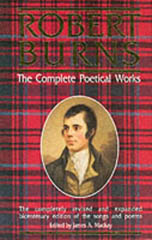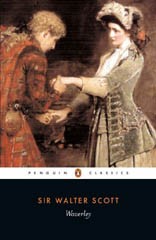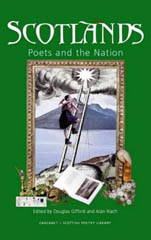Katrin Bosse
‘Scotland’s Cultural Standing and Identity’ Conference Report
 Robert Crawford (St Andrews) opened with a paper on ‘Scotland and Nostalgia’. He argued that fear of nostalgia must not lead Scotland to lose its sense of its complex cultural history – although often represented by stereotypes, Scotland’s history informs the work of contemporary artists in significant ways. Examples might be the protagonists in Irving Welsh’s Trainspotting and James Kelman’s Busconductor Hines: distorted and conflicted ‘ignoble heroes’ they might be, but they can be seen to have a place in Sir Walter Scott’s ‘noble hero’ tradition.
Robert Crawford (St Andrews) opened with a paper on ‘Scotland and Nostalgia’. He argued that fear of nostalgia must not lead Scotland to lose its sense of its complex cultural history – although often represented by stereotypes, Scotland’s history informs the work of contemporary artists in significant ways. Examples might be the protagonists in Irving Welsh’s Trainspotting and James Kelman’s Busconductor Hines: distorted and conflicted ‘ignoble heroes’ they might be, but they can be seen to have a place in Sir Walter Scott’s ‘noble hero’ tradition.
In ‘Proud to be Scots’ Valentina Bold (Glasgow) focused on the Scottish Parliament Openings of 1999 and 2004, as rites of passage, and unifying moments for the nation. The performance of a Burns song, she saw as much more than a musical ornament – this signified a conjuncture of old traditions (‘Riding of the Parliament’) with a new sense of pride in the Scottish heritage.
The paper submitted by Christopher Harvie (T
übingen), read by Valentina Bold, put forward the question ‘Scotland the Semi-Nation, or: Where Does the Grand Narrative Go From Here?’ and looked at possible models for Scotland in the post-modern or neo-modern worlds. Harvie argued that, unlike Wales, when the grid of its nineteenth century industrial accomplishments crumbled, Scotland suffered a loss of identity which resulted in a social malaise which continues to hinder its development. What is needed is for Scotland to reinvent its ‘imaginative world’ and embrace a refreshed, international perspective.
 In ‘We Are All Becoming Scottish Again’, Sigrid Rieuwerts’ (Mainz) identified the extent to which Burns, Scott and the numerous antiquarians who built a repository of Scotland’s poetry and song contributed to its sense of nationhood.
In ‘We Are All Becoming Scottish Again’, Sigrid Rieuwerts’ (Mainz) identified the extent to which Burns, Scott and the numerous antiquarians who built a repository of Scotland’s poetry and song contributed to its sense of nationhood.
Ian Galbraith (Wiesbaden), the co-editor of a German-Scottish poetry anthology, discussed the challenge of how the particular ‘Scottishness’ of a poem can be rescued in a target language.
Stuart Gillespie (Glasgow) presented a paper on ‘The Translation of Scottish Literature into German: Historical and Statistical Data and How to Use It’. He described the development of the Bibliography of Scottish Literature in Translation (BOSLIT), which contains more than 4200 translated works of Scottish writings. German leads this list of translations, which indicates how well received Scottish literature is in Germany.
 Ian Campbell (Edinburgh), in, ‘Getting to Know Scotland’, analysed the effect on Scotland’s social structure brought about by the inauguration and expansion of the railway system in the nineteenth century. Contrary to a wide-spread belief, the railways did not bring prosperity to rural areas but drained villages, luring inhabitants away and forcing market places to shut down – changes documented in John Galt’s Annals of the Parish, a graphic account of how modernisation estranged urban society from its rural counterpart. This has led to the misconceived notion that somehow, somewhere, an ‘unchanged Scotland’ has been preserved. Campbell predicted that it will take many modern authors to change this misconception.
Ian Campbell (Edinburgh), in, ‘Getting to Know Scotland’, analysed the effect on Scotland’s social structure brought about by the inauguration and expansion of the railway system in the nineteenth century. Contrary to a wide-spread belief, the railways did not bring prosperity to rural areas but drained villages, luring inhabitants away and forcing market places to shut down – changes documented in John Galt’s Annals of the Parish, a graphic account of how modernisation estranged urban society from its rural counterpart. This has led to the misconceived notion that somehow, somewhere, an ‘unchanged Scotland’ has been preserved. Campbell predicted that it will take many modern authors to change this misconception.
 In ‘The Invention of Heroic Scotland in Early Nineteenth Century Literature’, Barbara Schaff (M
In ‘The Invention of Heroic Scotland in Early Nineteenth Century Literature’, Barbara Schaff (M
ünchen) argued that the myth of a heroic, archaic and predominantly masculine Scotland, supported by films like Braveheart and Rob Roy, has its roots in works like Walter Scott’s Waverley, a novel that depicts strong homosocial bonding of men.
‘Only to Serve the Publick’: Scotland as seen through the Eyes of Nathaniel Crouch’ by Frauke Reitemeier (G
öttingen) illuminated Crouch’s central role in perpetuating the English perception of the Scottish as ‘troublemakers’. Narrating Scottish history to a readership that, though literate, lacked comprehensive education, Crouch gave his portrayal of the Scots a negative twist, referring to them as an uncivilised savages, cowards, and brutes.
Bill Bell (Edinburgh) discussed ‘Whaer’s Wullie Shakespeare’ – The Field of Scottish Literary Production’. The Golden Age of the Scottish bookmarket and its domination of the British literary production in the eighteenth and early nineteenth centuries was a phenomenon that can be attributed to the fact that, compared with England, Scottish society had a particularly strong quotient of highly educated, entrepreneurs.
In ‘Strangers in Paradise: The first tourists in Scotland’, James Holloway (Edinburgh), director of the Scottish National Portrait Gallery, took his theme as the portrayal of Scottish landscape. In the accompanying slideshow, he drew out the significance of additions and omissions in various eighteenth- and nineteenth-century paintings, and argued that pictures were usually not intended to depict a real place or setting, but rather an imaginary, ideal landscape. Collaborations on books between painters and authors contributed to this process by overlaying the factual with fictional, thus influencing people’s perception of Scotland as an imaginary place.
George Dalgleish (Edinburgh), curator of the Scottish Collections at the National Museum of Scotland, talked about ways of ‘Representing Scotland’s Past in the Museum of Scotland’ through its artefacts. The centrepiece of the museum’s collection is the private collection of the Earl of Buchan and colleagues, founders of the Society of Antiquaries of Scotland. He demonstrated that, while in the literary field ‘nostalgia’ may be perceived as something to be wary of, the musical world rather savours this feeling.
Ronald Walker (Germersheim), in ‘With a Hankering to Make Ourselves God – Providence and the Individual in John Galt’s Scotland’, addressed the growing interest in the psychological aspects of Galt’s fictional characters and his belief that the ‘simple’ rural man and woman were closer to an ideal of humanity than their more educated, urban counterparts.
 Douglas Gifford Glasgow) took the audience on a virtual tour through eight periods of Scottish poetry, spanning 1,000 years of literary production. In ‘From Saint Columba to Edwin Morgan: Making Poetry out of Scotland’, he took examples from Scotlands: Poets and the Nation (which he co-edited with Alan Riach) and gave a detailed analysis of the double function of Scottish poets as precursors or as commentators in the endless process of forming a sense of national identity.
Douglas Gifford Glasgow) took the audience on a virtual tour through eight periods of Scottish poetry, spanning 1,000 years of literary production. In ‘From Saint Columba to Edwin Morgan: Making Poetry out of Scotland’, he took examples from Scotlands: Poets and the Nation (which he co-edited with Alan Riach) and gave a detailed analysis of the double function of Scottish poets as precursors or as commentators in the endless process of forming a sense of national identity.
Robert Crawford and Ian Galbraith completed the event with readings from their poetry.
‘Scotland’s Cultural Standing and Identity’ was sponsored by the British Council, the Deutsche Forschungsgemeinschaft, Nolte Möbel, Germersheim, and by the Zentrum für Interkulturelle Studien of Mainz University. The conference was hosted by the Faculty of Applied Linguistics and Cultural Studies of Mainz University in Germersheim and was organised by Professors Klaus Peter Müller and Bernhard Reitz.
© Katrin Bosse and Lothar Görke 2006

Comments